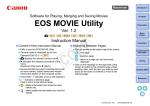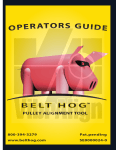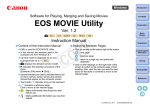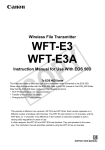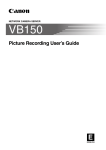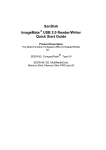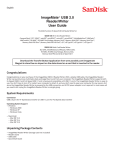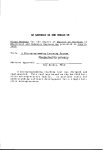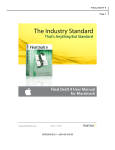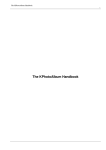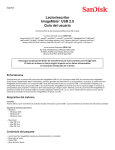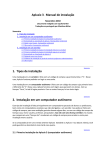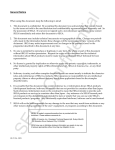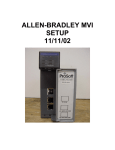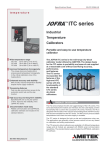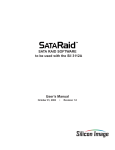Download EOS MOVIE Utility for EOS
Transcript
Introduction Software for Viewing, Merging and Saving Movies Contents EOS MOVIE Utility for EOS-1D C Ver. 1.0 Instruction Manual Content of this Instruction Manual EMU is used for EOS MOVIE Utility for EOS-1D C. indicates the selection procedure of the menu. (Example: [File] menu [Quit].) Square brackets are used to indicate items such as menu names, button names and window names that appear on the computer screen. Text inside < > indicates a key on the keyboard. ** indicates a reference page. Click to move to the relevant page. : Marks information that should be read before use. : Marks additional information you may find helpful. Basic Screen Viewing Switching Between Pages Click on arrows on the bottom right of the screen. C Preparation Y: next page P O Confirming File Information : previous page : return to a page you had previously displayed Click on the headings on the right side of the screen to switch to the contents page of that heading. Also, click the item you want to read about on the table of contents to move to the relevant page. Saving Quitting EMU Reference © CANON INC. 2012 CCS-M055EMUME-000 READ CAREFULLY BEFORE USING! CANON SOFTWARE LICENSE AGREEMENT IMPORTANT - READ THIS AGREEMENT BEFORE USING THE SOFTWARE ON THE CD-ROM IN THIS BOX. BY USING THE SOFTWARE, YOU AGREE TO BE BOUND BY THE TERMS OF THIS AGREEMENT. This is a license agreement (the [Agreement]) between you and Canon Inc. ([Canon]). IF YOU DO NOT AGREE TO THE TERMS AND CONDITIONS OF THIS AGREEMENT, DO NOT USE THE SOFTWARE PROGRAM ON THE CD-ROM AND THE USER MANUAL IN THIS BOX (COLLECTIVELY, THE [SOFTWARE]) AND RETURN THE SOFTWARE WITHIN 30 DAYS FROM THE DATE OF PURCHASE TO YOUR POINT OF PURCHASE FOR A REFUND. In consideration of the right to use the SOFTWARE, you agree to abide by the terms and conditions of this Agreement. 1. LICENSE: Canon grants you the non-exclusive right to use the SOFTWARE only on a single computer. You may physically transfer the SOFTWARE from one computer to another provided that the SOFTWARE is used on only one computer at a time. You shall not install or use the SOFTWARE on a network, multiple CPU, multiple site arrangement, or any other hardware configuration where the SOFTWARE is accessible to more than one CPU or to more than one user. YOU SHALL NOT ASSIGN, SUBLICENSE, RENT, LEASE, LOAN, CONVEY OR OTHERWISE USE, TRANSFER, COPY, TRANSLATE, CONVERT TO ANOTHER PROGRAMMING LANGUAGE, ALTER, MODIFY, DECOMPILE OR DISASSEMBLE THE SOFTWARE, IN WHOLE OR IN PART, EXCEPT AS EXPRESSLY PROVIDED IN THIS AGREEMENT. 2. BACK-UP COPY: You may make one copy of the SOFTWARE solely for back-up purposes, or copy the SOFTWARE onto the permanent storage device (e.g. a hard disk) of your computer and retain the original for back-up purposes. Any other copying of the SOFTWARE is a violation of this Agreement. You must reproduce and include the copyright notice on the back-up copy. 3. SUPPORT AND UPDATES: Canon is not responsible for providing maintenance or support for use of the SOFTWARE. No updates, fixes or support will be made available for the SOFTWARE. 4. LIMITED WARRANTY AND LIMITATION OF LIABILITY: It is your responsibility to choose, maintain and match the hardware and software components of your computer system. Thus Canon does not guarantee uninterrupted service or correction of errors or that the functions or performance of the SOFTWARE will meet your requirements. THE SOFTWARE IS LICENSED ON AN [AS IS] BASIS AND WITHOUT WARRANTY OF ANY KIND. The CD-ROM storing the SOFTWARE is warranted only against defective material under normal use for a period of ninety (90) days after purchase from an authorized Canon dealer as evidenced by your sales receipt. Your sole remedy for a defective CD-ROM shall be replacement of the same without charge when returned by you at your expense to your point of purchase and proven to be defective upon inspection. The replacement CD-ROM will be warranted for the remainder of the original ninety (90) day warranty period of the defective CD-ROM. The limited warranty does not apply if the failure of the CD-ROM resulted from accident, abuse or misapplication of the SOFTWARE and shall not extend to anyone other than the original user of the SOFTWARE. EXCEPT AS SPECIFICALLY SET FORTH IN THIS PARAGRAPH 4, CANON, CANON’S SUBSIDIARIES, DISTRIBUTORS AND DEALERS DISCLAIM ALL WARRANTIES, EXPRESS OR IMPLIED, INCLUDING ANY WARRANTY OF MERCHANTABILITY OR FITNESS FOR A PARTICULAR PURPOSE, WITH RESPECT TO THE SOFTWARE. NEITHER CANON NOR ANY OF CANON’S SUBSIDIARIES, DISTRIBUTORS OR DEALERS IS LIABLE FOR ANY DAMAGES HOWSOEVER CAUSED, INCLUDING WITHOUT LIMITATION, DIRECT, CONSEQUENTIAL OR INCIDENTAL LOSS OR DAMAGE INCLUDING LOSS OF PROFITS, EXPENSE OR INCONVENIENCE HOWSOEVER CAUSED OR ARISING OUT OF THE SOFTWARE OR THE USE THEREOF. NEITHER CANON, NOR ANY OF CANON’S SUBSIDIARIES, DISTRIBUTORS OR DEALERS SHALL HAVE ANY OBLIGATION TO INDEMNIFY YOU AGAINST ANY CLAIM OR SUIT BROUGHT BY A THIRD PARTY ALLEGING THAT THE SOFTWARE OR THE USE THEREOF INFRINGES ANY INTELLECTUAL PROPERTY OF SUCH THIRD PARTY. 5. TERM: This Agreement is effective upon your using the SOFTWARE and remains in effect until expiration of all copyright interests in the SOFTWARE unless earlier terminated. You may terminate this Agreement by destroying the SOFTWARE. This Agreement will also terminate without notice to you if you fail to comply with any of the terms of this Agreement and you must then promptly return the SOFTWARE. In addition, Canon may enforce its other legal rights. 6. U.S. GOVERNMENT RESTRICTED RIGHTS NOTICE: The SOFTWARE is provided with restricted rights. Use, duplication or disclosure is subject to restrictions as set forth in either subparagraph (c) (1) (ii) of the Rights in Technical Data and Computer software clause at DFARs 252.227-7013 or subparagraph (c) (1) and (2) of the Commercial Computer Software Restricted Rights Clause at FAR 52.227-19, as applicable. 7. SEVERABILITY: In the event that any provision of this Agreement is declared or found to be illegal by any court or tribunal of competent jurisdiction, such provision shall be null and void with respect to the jurisdiction of that court or tribunal and all the remaining provisions of this Agreement shall remain in full force and effect. Y P O 8. CONTROLLING LAW: The terms of this Agreement as it relates to purchases of the Software in the United States of America shall be governed and construed in all respects in accordance with the laws and regulations of the State of New York, without reference to choice of law principles. The terms of this Agreement as it relates to purchases of the Software in Canada shall be governed by the laws of the province of Ontario. C 9. OWNERSHIP: All rights, including but not limited to copyrights and trade secret rights, to the SOFTWARE belong to Canon, its affiliated corporations and third party licensors. Your use of the SOFTWARE is subject to the United States, Canada and other applicable copyright and trademark laws and nothing in this Agreement constitutes a waiver of the rights of Canon, its affiliated corporations and third party licensors under such laws. Nothing contained in Paragraph 1 shall be construed to give Canon any ownership rights in any images, graphics or textual material that you save in connection with the Software. 10.ACKNOWLEDGEMENT: BY USING THE SOFTWARE, YOU ACKNOWLEDGE THAT YOU HAVE READ THIS AGREEMENT, UNDERSTOOD IT, AND AGREE TO BE BOUND BY ITS TERMS AND CONDITIONS. YOU ALSO AGREE THAT THIS AGREEMENT IS THE COMPLETE AND EXCLUSIVE STATEMENT OF AGREEMENT BETWEEN YOU AND CANON CONCERNING THE SUBJECT MATTER HEREOF AND SUPERSEDES ALL PROPOSALS OR PRIOR AGREEMENTS, VERBAL OR WRITTEN, AND ANY OTHER COMMUNICATIONS BETWEEN THE PARTIES RELATING TO THE SUBJECT MATTER HEREOF. NO AMENDMENT TO THIS AGREEMENT SHALL BE EFFECTIVE UNLESS SIGNED BY A DULY AUTHORIZED OFFICER OF CANON. Introduction Contents Preparation Basic Screen Viewing Confirming File Information Saving Quitting EMU Reference 1 Introduction EOS MOVIE Utility for EOS-1D C (hereinafter, “EMU”) is software for viewing, merging and saving movies shot on a CINEMA EOS camera EOS-1D C. Main Features of EMU With EMU, you can view movie files shot with an EOS-1D C. You can also use View Assist for viewing movies shot with Canon Log gamma. In addition, you can merge multiple 4 GB movie files created from one clip into a single file, and save it. What is Canon Log gamma? This function allows rich gradation expression from dark points to bright points, applying a wide dynamic range. It maximizes the excellent capability of CMOS sensor. What is a movie clip? A movie recorded in a single shooting operation is called a movie clip. With this software, you cannot view movies shot on a camera other than the EOS-1D C. System Requirements OS Computer CPU Graphics board RAM Display Mac OS X 10.7 Mac OS X 10.8 Macintosh with one of the above OS preinstalled Core i7 2.93 GHz equivalent or more recommended C Contents ATI Radeon HD 5870 equivalent or more recommended Minimum 4 GB XGA (1024 x 768 pixels) or more When editing 4K movies with this software, using CF cards and CF card readers with the following specifications is recommended. • CF card: Supporting UDMA 7, 100 MB/sec. or higher effective writing/reading speed • CF card reader: USB 3.0 connection, supporting UDMA 7, 100 MB/ sec. or higher effective reading speed For information related to operation verification of CF cards and CF card readers, refer to Canon Web site, etc. See the Canon Web site for support information including the latest OS. Y P O Introduction Preparation Basic Screen Viewing Confirming File Information Saving Quitting EMU Reference 2 Contents Introduction ................................................................ 2 Trademark Acknowledgments .................................... 18 Introduction System Requirements................................................ 2 Contents Installing the Software................................................ 4 Starting up EMU......................................................... 4 Basic Screen .............................................................. 5 Main Window ................................................................ 5 Preparation Viewing a Movie Clip.................................................. 6 Movie Clip Viewing ....................................................... 6 Moving the Movie Clip Display Position........................ 7 Viewing a Movie Shot with Canon Log Gamma ........... 8 Viewing in Full Screen .................................................. 8 Operations Using Keyboard.......................................... 8 Switching the Movie Display Size ................................. 9 Confirming the Movie File Information ..................... 10 Merging and Saving Movie Files .............................. 11 Checking the Movie Files in a Movie Clip .................. 11 Merging Split Movie Files and Saving as a Single File ... 12 Merging All the Split Movie Files in the Folder and Saving as a Single File .......................................... 12 Merging Split Movie Files for a Single Movie Clip and Saving as a Single File .............................................. 14 Basic Screen Viewing C Y P O Confirming File Information Saving Quitting EMU Reference Quitting EMU............................................................ 15 Reference................................................................. 15 Troubleshooting ......................................................... 15 Error Messages ......................................................... 16 Uninstalling the Software ........................................... 17 About This Instruction Manual ................................... 18 3 Installing the Software Starting up EMU Introduction Click the shortcut in your desktop’s Dock. When installing this software, an administrator-level privilege is required. Contents the compressed EMU file (.gz format) 1 Double-click downloaded from the Canon Web site to open it. 2 Double-click “emum-1-x-x-xxx-9l.dmg” in the folder. the disk image “emum100”, and 3 Double-click double-click “EMUInstaller” in the displayed folder. 4 Follow onscreen instructions for installation. Click Preparation EMU starts up and the main window appears. The disk image “emum100” is mounted. Basic Screen Viewing C Y P O Confirming File Information Saving Quitting EMU Starting up several EMU at the same time is not possible. Reference 4 Basic Screen Introduction Main Window You can view movie clips, merge split movie files into a single file and save it, and perform other operations in the main window. Menu Menu to execute all functions. Contents Preparation Basic Screen Viewing C Y P O Preview area Displays a clip. Confirming File Information Saving Quitting EMU Reference Control area Controls for viewing movie clips and merging split movie files to be saved as a single file. 5 Viewing a Movie Clip Introduction The method for viewing a movie clip is described here. It is recommended that you first copy the folder where the movie clip is saved on the memory card to your computer with a card reader. Movie files shot on a camera are recorded on the memory card with the folder structure shown below. Contents 㻌 DCIM Movie Clip Viewing 1 100CANON MVI_xxxx.MOV MVI_xxxx.MOV In the main window, select the [File] menu [Open...]. Preparation MVI_xxxx.MOV A dialog box for selecting a folder appears. 2 Select the folder where the movie clip to view is saved, and then click the [Open] button. Basic Screen MVI_xxxx.MOV 101CANON MVI_xxxx.MOV Viewing MVI_xxxx.MOV MVI_xxxx.MOV C Y P O Confirming File Information MVI_xxxx.MOV 102CANON MVI_xxxx.MOV Saving MVI_xxxx.MOV MVI_xxxx.MOV The [Clip list] dialog box appears. After inserting the memory card in the card reader, you can also connect the reader to the computer to select folders on the memory card directly. You cannot connect the camera to the computer to directly select folders on the camera’s memory card. Quitting EMU MVI_xxxx.MOV 㻌 With this software, if the above folder structure is not maintained, it may not be possible to view the movie clips properly. When viewing movie clips, make sure the above folder structure is maintained and the DCIM folder at the upper layer of the folder structure is selected. Even when the folder structure is maintained, be aware that it may not be possible to view the clips properly if the name of the selected folder, originally [DCIM], has been changed to another name. Reference 6 Introduction the movie clip to be viewed in the [Clip list] 3 Select dialog box. Moving the Movie Clip Display Position You can move the display position of the movie clip by dragging the frame position slider left or right, or by clicking the previous frame button or next frame button. Contents Preparation Basic Screen Frame position slider Previous frame button (one frame back) The image of the movie clip appears in the main window. In the [Clip list] dialog box, you can switch between movie clips with the <><> keys on the keyboard or by clicking the mouse. Even if you close the [Clip list] dialog box, the content of the list is saved. If you select [Clip list...] from the [View] menu, the [Clip list] reappears. C Y P O Next frame button (one frame forward) Viewing Confirming File Information Saving Quitting EMU Reference 7 Introduction Viewing a Movie Shot with Canon Log Gamma If you view a movie that was shot with Canon Log gamma (p.2) as it is, image will look dark and with a low contrast. If you apply a look-up table (LUT) and view the clip, you can check the clip with an image close to normal display. 1 Checkmark the [LUT] checkbox. If the movie was shot without Canon Log gamma, you cannot checkmark the [LUT] checkbox. 2 View the selected movie. Perform the operations described in “Movie Clip Viewing” (p.6). The LUT is applied and the movie is displayed. You can check or uncheck the LUT checkbox with the <B> key on the keyboard. For movies shot with Canon Log gamma, [On] is displayed for the [Canon Log] item in the shooting information (p.10). Viewing in Full Screen Contents Display a movie. 1 In the main window, select the [View] menu 2 Screen]. Follow operations in “Movie Clip Viewing” (p.6). [Full The movie viewed is displayed in full screen. You can also double-click the preview area to display the movie in full screen. To cancel full screen display, press the <Esc> key or double-click the preview area. Preparation Basic Screen Viewing Operations Using Keyboard Y P O You can use the keyboard for the following operations. CKeyboard Confirming File Information Operation <> Previous frame <> Next frame <Home> Move to first frame <End> Move to last frame <B> Enable/disable look-up table (LUT) <D> Displays [Merge Files] dialog box <F> Switches to full screen display <V> Switch display mode ([100% view]/[Fit to window]) Saving Quitting EMU Reference 8 Introduction Enlarged position in guide area Switching the Movie Display Size You can apply either of [Fit to window] mode and [100% view] mode as a method for displaying a movie in the preview area. Contents Select the [View] menu [Fit to window]/[100% view]. Preparation The image is displayed in the preview area with the selected display mode. [Fit to window] mode Basic Screen [100% view] mode Viewing C In [Fit to window] mode, the image is displayed completely within the preview area. In [100% view] mode, the image is enlarged to 100% (actual pixel size) and displayed in the preview area. Checkmark the [100%] checkbox in the control area to view in [100% view] mode. Remove the checkmark from the [100%] checkbox to view in [Fit to window] mode. To change the display position of an image in [100% view] mode, drag the image in the preview area. Y P O Confirming File Information Saving Quitting EMU Reference 9 Confirming the Movie File Information Introduction You can display and confirm shooting information for movie clips. In the main window, select the [View] menu 1 list...]. [Clip Contents The [Clip list] dialog box appears. Note that this function is available after you select a folder in which the movie files to be confirmed are saved. If no folder is selected, follow steps 1 to 2 in “Movie Clip Viewing” (p.6) to select a folder. Preparation Basic Screen In the [Clip list] dialog box, select a movie clip to display its shooting information. 2 In the main window, select the [View] menu 3 [Shooting Information...]. Viewing The shooting information is displayed in the [Shooting Information] window. C Y P O Confirming File Information Saving Quitting EMU Reference 10 Merging and Saving Movie Files Introduction When you shoot movies with the EOS-1D C, the movie file will be split by 4 GB and multiple movie files will be created automatically, even for the single shooting. You can merge these multiple files and save them as a single file with this function. Contents Checking the Movie Files in a Movie Clip Preparation In EMU, the split movie files will be displayed as a single movie clip. You can check the structure of a movie clip and see the movie files that consist the movie clip in the procedures as below. 1 Basic Screen In the main window, select the [View] menu [Clip list...]. Movie file names are displayed in several lines for a movie clip made up of split movie files. The [Clip list] dialog box appears. To use this function, you must first select the folder in which the movie clips to check are saved. If a folder is not selected, follow steps 1 to 2 of “Movie Clip Viewing” (p.6) to select a folder. 2 In the [Clip list] dialog box, select the movie clip whose structure you want to check, then click while holding down the <control> key, and select [Show structure of the clip...] from the menu that appears. C Y P O Viewing Confirming File Information Saving Quitting EMU Reference The [Structure of Clip] dialog box appears. 11 Merging Split Movie Files and Saving as a Single File You can merge multiple split movie files in a movie clip and save them as a single file. The original movie files are kept as they are in the folder they were originally saved. 2 Introduction Contents Preparation Merging All the Split Movie Files in the Folder and Saving as a Single File 1 Click the [ ] button for [Folder for Files to be Merged] and then select the folder in which the movie files to be merged are saved. All the movie files saved in the selected folder will be merged. Click the merge file button in the main window. Basic Screen Viewing The [Merge Files] dialog box appears. In the main window, you can also select the [Tools] menu [Merge split files...] to display the [Merge Files] dialog box. C Y P O Confirming File Information Saving Quitting EMU Reference 12 Introduction Movie files shot on a camera are recorded on the memory card with the folder structure shown below. the [ ] button for [Folder for Exported Files] 3 Click and then select the folder for saving the merged movie file. 㻌 DCIM 100CANON Contents MVI_xxxx.MOV MVI_xxxx.MOV Preparation MVI_xxxx.MOV 4 MVI_xxxx.MOV 101CANON MVI_xxxx.MOV Click the [Start] button. Basic Screen Viewing MVI_xxxx.MOV MVI_xxxx.MOV Merging and saving starts. A message appears when merging and saving are complete. Y P O MVI_xxxx.MOV 102CANON Confirming File Information C If you checkmark [Automatically Generate Subfolders], a MVI_xxxx.MOV MVI_xxxx.MOV MVI_xxxx.MOV MVI_xxxx.MOV 㻌 With this software, if the above folder structure is not maintained, it may not be possible to merge the split movie files properly. When performing "Merge all the split movie files in the folder and save as a single file" operation, make sure the above folder structure is maintained and the DCIM folder at the upper layer of the folder structure is selected. Even when the folder structure is maintained, be aware that it may not be possible to merge the movie files properly if the name of the selected folder, originally [DCIM], has been changed to another name. subfolder is created in the folder for the merged movie file selected in step 3, then the merged movie file is saved there. A file can be saved without changing its file name even if another file with the same file name is already in the folder. If you checkmark [Rename Files], you can change the file name of the merged movie file when saving it. To create file names with consecutive numbering, enter the initial value in the [Initial Value for Consecutive Numbers] box. You can enter an initial value that is up to 5 digits. Checkmark [Remember Consecutive Numbering] to allow consecutive numbering to continue even after closing the [Merge Files] dialog box and opening it again to merge and save movie files. If you checkmark [Include Unsplit Clips], movie files not split but saved in the folder selected in step 2 are copied to the folder for saving the merged file together. Saving Quitting EMU Reference 13 Introduction Merging Split Movie Files for a Single Movie Clip and Saving as a Single File In the main window, select the [View] menu 1 list...]. Contents [Clip Preparation The [Clip list] dialog box appears. Note that this function is available after you select a folder in which the movie files to be merged are saved. If no folder is selected, follow steps 1 to 2 of “Movie Clip Viewing” (p.6) to select a folder. Basic Screen [Clip list] dialog box, select the movie clip to 2 Inbethe merged, then click while holding down the Viewing <control> key, and select [Merge split files...] from the menu that appears. The [Merge Files] dialog box appears. the [ ] button for [Folder for Exported Files] 3 Click and then select the folder for saving the merged movie file. 4 Click the [Start] button. Merging and saving starts. A message appears when merging and saving are complete. C Y P O Confirming File Information Saving Quitting EMU Reference 14 Quitting EMU In the main window, select the [EOS MOVIE Utility for EOS-1D C] menu [Quit EOS MOVIE Utility]. EMU quits. Reference Introduction Troubleshooting If EMU is not operating correctly, refer to the information below. Contents EMU does not work Starting up several EMU at the same time is not possible. Even if your computer has the RAM capacity (memory) described in the system requirements (p.2), if other applications are running at the same time as EMU, you may not have sufficient RAM (memory). Quit applications other than EMU. Preparation Basic Screen Viewing C Y P O Confirming File Information Saving Quitting EMU Reference 15 Introduction The merge process has been failed. Error Messages If an error message appears, refer to the information below. Message Cause and solution Cannot create a folder at the selected destination. The memory card specified for the save destination is write-protected. Insert a writable memory card. Please enter consecutive numbers. No consecutive numbering is entered. Enter an initial value for consecutive numbering when there are several movie clips with movie files to be merged. The size of the file you are saving is not supported on the destination file system. The file system specified for the save destination does not support the size of the file being saved. Change the save destination. Sufficient consecutive numbers are not provided for the files. Consecutive numbering for file names exceeds 99999. Change the value entered for numbering or the file save destination. EOS MOVIE Utility has already started by other user. Log into the user account in Macintosh in which EOS MOVIE Utility is running, quit EOS MOVIE Utility, and start it up again. 4 GB or larger files may not be supported on the file system of output destination. Do you want to continue? The merged movie file may not be saved to the drive where the save destination folder is located. Check that the file system specified for the save destination drive supports files of 4 GB or larger. Could not merge because there was not enough available space. There is insufficient space on the drive where the save destination folder is located. Create enough space or change the save destination, and then repeat the merge process. Check that there is a save destination folder. If the save destination folder is on an external storage device, check that it is connected to the computer correctly. Contents Preparation Basic Screen Viewing C Y P O Confirming File Information Saving Quitting EMU Reference 16 Introduction Uninstalling the Software Quit any applications before uninstalling the software. Log into the account used when installation was performed. When you have moved the folders and the software to be deleted to the Trash, select the [Finder] menu [Empty Trash...] and empty the Trash. You cannot reinstall the software until you have emptied the Trash. Contents Preparation 1 Display the folder in which the software is saved. Basic Screen Open the [Canon Utilities] folder. Viewing C Y P O Confirming File Information Saving Quitting EMU the folder for the software to be uninstalled to 2 Drag the Trash. [Finder] menu on the desktop [Empty 3 Select Trash...]. Reference The software is deleted. When uninstallation ends, restart your computer. You cannot retrieve deleted data once you have emptied the Trash, so be particularly careful when deleting data. 17 About This Instruction Manual Introduction It is prohibited to reproduce, in whole or part, the contents of this Instruction Manual without permission. Canon may change without notice the software specifications and contents of this Instruction Manual. The software screens and displays printed in this Instruction Manual may differ slightly from the actual software. The content of this Instruction Manual has been reviewed thoroughly. However, if you should notice any errors or omissions, please contact a Canon Service Center. Please note that irrespective of the above-mentioned, Canon does not take responsibility for the outcome of the operation of the software. Contents Preparation Basic Screen Trademark Acknowledgments Macintosh is a trademark of Apple Inc., registered in the United States and other countries. Other names and products not mentioned above may be registered trademarks or trademarks of their respective companies. Viewing C Y P O Confirming File Information Saving Quitting EMU Reference 18



















